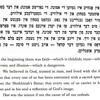1: Text excerpt, the opening of Elie Wiesel's "...Un di velt hot geshvign," 1956, with the English translation from the preface of "Night," 2006.
Elie Wiesel's original memoir in Yiddish, ...Un di velt hot geshvign, numbered 245 pages in length, and was published in Argentina in 1956 as part of the Dos poylishe yidntum (Polish Jewry) series. It was translated into French in 1958 with the help of writer François Mauriac, and was pared down to 178 pages. The English version of the text, published in 1960, was translated from the French (rather than the Yiddish) and further condensed to 116 pages. While Wiesel was minimally involved in the original English translation, his wife, Marion Wiesel, translated the 2006 edition of Night, which included some corrections and updates.
This passage is the opening of Elie Wiesel's memoir as it appeared in the original Yiddish text ...Un di velt hot geshvign (1956). The translation of the Yiddish is Elie Wiesel's own, included in the preface to Night.
Suggested Activity: Read the excerpt from ...Un di velt hot geshvign. Ask students to compare it to the way the memoir opens in English, with the story of Moishe the Beadle in Night (pages 3-7 in the 2006 Hill & Wang edition.) What are the main differences? What are the themes in the opening of the Yiddish original versus the English adaptation? What is the tone of each? Why might the Yiddish and English versions of the memoir begin differently?
Sources: Elie Wiesel, ...Un di velt hot geshvign (Buenos Aires: Tsentral-Farband fun Poylishe Yidn in Argentine, 1956), 7.
Elie Wiesel, Night, trans. Marion Wiesel (New York: Hill & Wang, 2006), x-xi.

